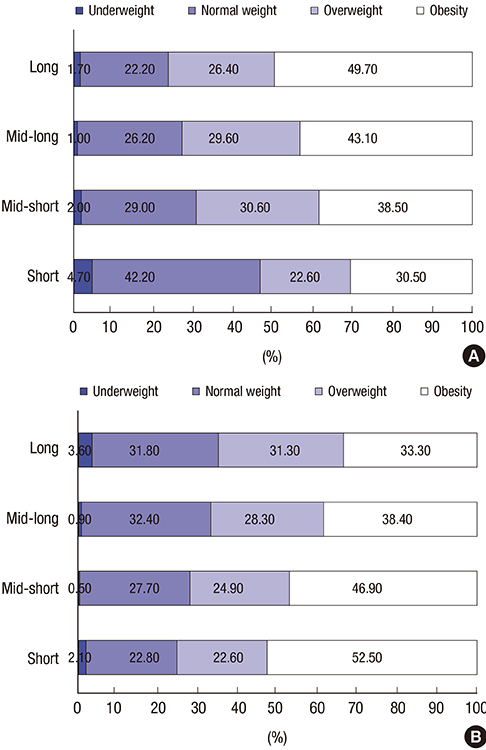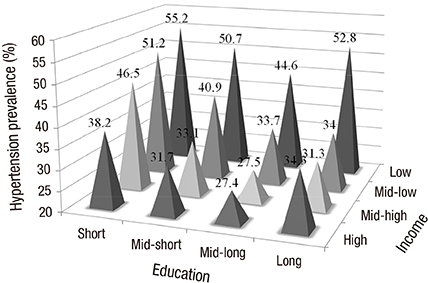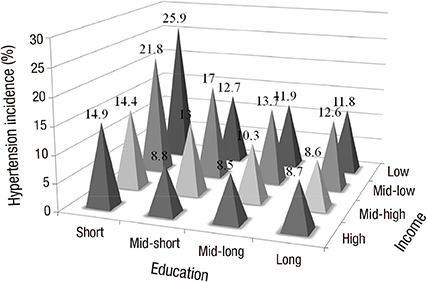J Korean Med Sci.
2016 Dec;31(12):1922-1928. 10.3346/jkms.2016.31.12.1922.
The Association between Parameters of Socioeconomic Status and Hypertension in Korea: the Korean Genome and Epidemiology Study
- Affiliations
-
- 1Department of Internal Medicine, Seoul National University Hospital, Seoul National University College of Medicine, Seoul, Korea. hylee612@snu.ac.kr
- 2Department of Preventive Medicine, Yonsei University College of Medicine, Seoul, Korea.
- 3Division of Cardiology, Severance Cardiovascular Hospital, Yonsei University College of Medicine, Seoul, Korea.
- 4Department of Internal Medicine, Bucheon St. Mary’s Hospital, The Catholic University of Korea, Bucheon, Korea.
- KMID: 2355620
- DOI: http://doi.org/10.3346/jkms.2016.31.12.1922
Abstract
- We investigated the association between socioeconomic status and hypertension in Korea, a country that has experienced a dynamic socioeconomic transition. We analyzed participants of a prospective cohort study"”the Korean Genome and Epidemiology Study"”enrolled between 2001 and 2003. We recruited 7,089 subjects who underwent a 4-year follow up till 2007. Education and income levels, which are important parameters for socioeconomic status, were stratified into 4 groups. Education level was defined as short (≤ 6 years), mid-short (7-9 years), mid-long (10-12 years), and long (≥ 12 years). Monthly income level was stratified as low (< 500,000 KRW), mid-low (500,000-1,499,999 KRW), mid-high (1,500,000-2,999,999 KRW) or high (≥ 3,000,000 KRW). At baseline, 2,805 subjects (39.5%) were diagnosed with hypertension. Education and income levels were inversely associated with the prevalence and incidence of hypertension (P < 0.001). In multivariate analysis, a shorter duration of education was significantly associated with a higher prevalence of hypertension (P < 0.001), but income level was not (P = 0.305). During the follow-up, 605 subjects (14.2%) were newly diagnosed with hypertension. In multivariate adjusted analysis, the hazard ratios (95% confidence interval) for incident hypertension across the longer education groups were 0.749 (0.544-1.032), 0.639 (0.462-0.884), and 0.583 (0.387-0.879), compared with the shortest education group. There was no significant association between incident hypertension and income across higher income groups: 0.988 (0.714-1.366), 0.780 (0.542-1.121), and 0.693 (0.454-1.056), compared with the lowest income group. In conclusion, education and income levels are associated with the prevalence and incidence of hypertension, but only education is an independent prognostic factor in Korea.
Keyword
MeSH Terms
Figure
Reference
-
1. Lawes CM, Vander Hoorn S, Rodgers A; International Society of Hypertension. Global burden of blood-pressure-related disease, 2001. Lancet. 2008; 371:1513–1518.2. Ezzati M, Lopez AD, Rodgers A, Vander Hoorn S, Murray CJ; Comparative Risk Assessment Collaborating Group. Selected major risk factors and global and regional burden of disease. Lancet. 2002; 360:1347–1360.3. Kearney PM, Whelton M, Reynolds K, Muntner P, Whelton PK, He J. Global burden of hypertension: analysis of worldwide data. Lancet. 2005; 365:217–223.4. Kaplan GA, Keil JE. Socioeconomic factors and cardiovascular disease: a review of the literature. Circulation. 1993; 88:1973–1998.5. Albert MA, Glynn RJ, Buring J, Ridker PM. Impact of traditional and novel risk factors on the relationship between socioeconomic status and incident cardiovascular events. Circulation. 2006; 114:2619–2626.6. Wang Y, Chen J, Wang K, Edwards CL. Education as an important risk factor for the prevalence of hypertension and elevated blood pressure in Chinese men and women. J Hum Hypertens. 2006; 20:898–900.7. Xu X, Niu T, Christiani DC, Weiss ST, Zhou Y, Chen C, Yang J, Fang Z, Jiang Z, Liang W, et al. Environmental and occupational determinants of blood pressure in rural communities in China. Ann Epidemiol. 1997; 7:95–106.8. Minh HV, Byass P, Chuc NT, Wall S. Gender differences in prevalence and socioeconomic determinants of hypertension: findings from the WHO STEPs survey in a rural community of Vietnam. J Hum Hypertens. 2006; 20:109–115.9. Conen D, Glynn RJ, Ridker PM, Buring JE, Albert MA. Socioeconomic status, blood pressure progression, and incident hypertension in a prospective cohort of female health professionals. Eur Heart J. 2009; 30:1378–1384.10. Vathesatogkit P, Woodward M, Tanomsup S, Hengprasith B, Aekplakorn W, Yamwong S, Sritara P. Long-term effects of socioeconomic status on incident hypertension and progression of blood pressure. J Hypertens. 2012; 30:1347–1353.11. Cha SH, Park HS, Cho HJ. Socioeconomic disparities in prevalence, treatment, and control of hypertension in middle-aged Koreans. J Epidemiol. 2012; 22:425–432.12. Kim YM, Jung-Choi K. Socioeconomic inequalities in health risk factors in Korea. J Korean Med Assoc. 2013; 56:175–183.13. Kim YJ, Kwak C. Prevalence and associated risk factors for cardiovascular disease: findings from the 2005, 2007 Korea National Health and Nutrition Examination Survey. Korean J Health Promot. 2011; 11:169–176.14. Lee HY, Won JC, Kang YJ, Yoon SH, Choi EO, Bae JY, Sung MH, Kim HR, Yang JH, Oh J, et al. Type 2 diabetes in urban and rural districts in Korea: factors associated with prevalence difference. J Korean Med Sci. 2010; 25:1777–1783.15. Colhoun HM, Hemingway H, Poulter NR. Socio-economic status and blood pressure: an overview analysis. J Hum Hypertens. 1998; 12:91–110.16. Zhang Q, Wang Y. Trends in the association between obesity and socioeconomic status in U.S. adults: 1971 to 2000. Obes Res. 2004; 12:1622–1632.17. Wang Y, Beydoun MA. The obesity epidemic in the United States--gender, age, socioeconomic, racial/ethnic, and geographic characteristics: a systematic review and meta-regression analysis. Epidemiol Rev. 2007; 29:6–28.18. Khang YH, Yun SC. Trends in general and abdominal obesity among Korean adults: findings from 1998, 2001, 2005, and 2007 Korea National Health and Nutrition Examination Surveys. J Korean Med Sci. 2010; 25:1582–1588.19. Park JI, Baek H, Jung HH. Prevalence of chronic kidney disease in Korea: the Korean National Health and Nutritional Examination Survey 2011-2013. J Korean Med Sci. 2016; 31:915–923.20. Shin C, Abbott RD, Lee H, Kim J, Kimm K. Prevalence and correlates of orthostatic hypotension in middle-aged men and women in Korea: the Korean health and genome study. J Hum Hypertens. 2004; 18:717–723.21. Baek TH, Lee HY, Lim NK, Park HY. Gender differences in the association between socioeconomic status and hypertension incidence: the Korean genome and epidemiology study (KoGES). BMC Public Health. 2015; 15:852.22. Ha KH, Kim HC, Park S, Ihm SH, Lee HY. Gender differences in the association between serum gamma-glutamyltransferase and blood pressure change: a prospective community-based cohort study. J Korean Med Sci. 2014; 29:1379–1384.23. 1999 World Health Organization-International Society of Hypertension guidelines for the management of hypertension. Guidelines Subcommittee. J Hypertens. 1999; 17:151–183.24. James PA, Oparil S, Carter BL, Cushman WC, Dennison-Himmelfarb C, Handler J, Lackland DT, LeFevre ML, MacKenzie TD, Ogedegbe O, et al. 2014 evidence-based guideline for the management of high blood pressure in adults: report from the panel members appointed to the Eighth Joint National Committee (JNC 8). JAMA. 2014; 311:507–520.25. Statistics Korea. Korean Statistical Information Service [Internet]. accessed on 22 June 2016. Available at http://kosis.kr/statisticsList/statisticsList_01List.jsp?vwcd=MT_ZTITLE&parentId=C#SubCont.26. Expert Consultation WH. Appropriate body-mass index for Asian populations and its implications for policy and intervention strategies. Lancet. 2004; 363:157–163.27. Ashfaq T, Anjum Q, Siddiqui H, Shaikh S, Vohra EA. Awareness of hypertension among patients attending primary health care centre and outpatient department of tertiary care hospital of Karachi. J Pak Med Assoc. 2007; 57:396–399.28. Addo J, Smeeth L, Leon DA. Socioeconomic position and hypertension: a study of urban civil servants in Ghana. J Epidemiol Community Health. 2009; 63:646–650.29. Min H, Chang J, Balkrishnan R. Sociodemographic risk factors of diabetes and hypertension prevalence in Republic of Korea. Int J Hypertens. 2010; 2010:410794.30. Samal D, Greisenegger S, Auff E, Lang W, Lalouschek W. The relation between knowledge about hypertension and education in hospitalized patients with stroke in Vienna. Stroke. 2007; 38:1304–1308.31. Paek KW, Chun KH. Moderating effects of interactions between dietary intake and socioeconomic status on the prevalence of metabolic syndrome. Ann Epidemiol. 2011; 21:877–883.32. Pickering T. Cardiovascular pathways: socioeconomic status and stress effects on hypertension and cardiovascular function. Ann N Y Acad Sci. 1999; 896:262–277.33. Baum A, Garofalo JP, Yali AM. Socioeconomic status and chronic stress. Does stress account for SES effects on health? Ann N Y Acad Sci. 1999; 896:131–144.34. Jin HS, An AR, Choi HC, Lee SH, Shin DH, Oh SM, Seo YG, Cho BL. Physical activity level of Korean adults with chronic diseases: The Korean National Health and Nutritional Examination Survey, 2010-2012. Korean J Fam Med. 2015; 36:266–272.35. Mensink GB, Deketh M, Mul MD, Schuit AJ, Hoffmeister H. Physical activity and its association with cardiovascular risk factors and mortality. Epidemiology. 1996; 7:391–397.36. Andersen UO, Jensen G. Decreasing population blood pressure is not mediated by changes in habitual physical activity. Results from 15 years of follow-up. Blood Press. 2007; 16:28–35.37. Park MY, Kim SH, Cho YJ, Chung RH, Lee KT. Association of leisure time physical activity and metabolic syndrome over 40 years. Korean J Fam Med. 2014; 35:65–73.38. Lim S, Jang HC, Lee HK, Kimm KC, Park C, Cho NH. A rural-urban comparison of the characteristics of the metabolic syndrome by gender in Korea: the Korean health and genome study (KHGS). J Endocrinol Invest. 2006; 29:313–319.
- Full Text Links
- Actions
-
Cited
- CITED
-
- Close
- Share
- Similar articles
-
- Effects of Marital Status and Income on Hypertension: The Korean Genome and Epidemiology Study (KoGES)
- Relationship between Inequalities in Health and Inequalities in Socioeconomic Status
- A Short History of the Genome-Wide Association Study: Where We Were and Where We Are Going
- Influences of Socioeconomic Status on Short Stature in Childhood
- Association between DIO2 Thr92Ala polymorphism and hypertension in patients with hypothyroidism: Korean Genome and Epidemiology Study




